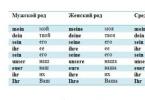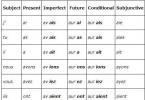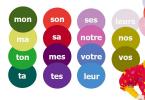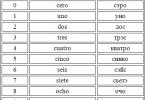When talking about ourselves, our appearance, at a doctor's appointment, when talking with friends, colleagues, buying clothes, we very often mention body parts. If you are learning English, then this topic should not be missed. Having mastered all the vocabulary, you will be able to travel without problems, visit shops abroad and, if necessary, seek medical help. So let's get started...
The question of where to start studying body parts in English puzzles many. It is best to start assimilation of the large components of our body, then consider each element in detail. We will present all the information in a table to make it easier for you to navigate.
External parts of the body
The main parts include, of course, large elements: torso, head, legs, arms. Each of them has components. How does it all sound in English? Interesting?
parts of body
A little bit of anatomy
When all the basic words on this topic are already familiar, then you can move on to the use cases.
Set expressions
With body parts in English, there are many idiomatic expressions that are not amenable to either word by word or logical translation. Your task is to learn them by heart. For example:
Hands (with the word arm):
to be up in arms- Be ready to get your way.
to give right arm to do it- give everything (give a lot) to do it.
to twist someone's arm- twist hands, push
Eyes (with the word eyes):
to keep an eye on something- keep an eye on something
to have eyes in the back of the head- have eyes in the back of the head
Someone's eyes are bigger than someone's stomach- eat with eyes
Hair (with the word hair):
let someone's hair down- relax, take a break
keep your hair on don't freak out, calm down
to be tearing someone's hair out- be obsessed with something
Leg (with the word leg):
to be pulling someone's leg = fool around, joke
It cost an arm and a leg = is too expensive
to have not got a leg to stand on = no evidence.
Body parts in English is not a difficult but important topic. Without her understanding, knowledge of all the words will be very difficult to move forward. Yes, at any time you can look into the dictionary. But very frequent peeping is tiring. We have given you the entire list, so put down the dictionary and study with us. Don't try to remember everything at once. It is best to do this by the groups that we have presented to you.
We can say with confidence that you know or at least heard this amusing cartoon song that colorful octopuses sang cheerfully: “Point, dot, comma,” a wry face came out. Arms, legs, cucumber - a little man appeared! Hmm, well, how to talk about the body or its parts in English? So that such questions do not arise, and you are fluent in this useful vocabulary, today we will talk and analyze using examples of body parts in English. Are you ready? Let's go!
Parts of the torso
chest- chest / chest
breast- breast
belly/abdomen["belɪ /" æbdəmen] - belly
genitals["dʒenɪtlz] - genitals
groin- groin
nipple["nɪpl] - nipple
waist- waist
navel["neɪv (ə) l] - navel
small of the back/ loin - lower back
bottom /boom /butt["bɒtəm / bʌm / bʌt] - ass (slang)
buttock- buttock
back- back
Parts of the hand
forearm["fɔ: (r)ɑ: m] - forearm
shoulder["ʃəuldə] - shoulder
armpit["ɑ:mpɪt] - armpit
arm[ɑ: m] - hand
elbow["elbəu] - elbow
hand- wrist
wrist- wrist
finger["fɪŋgə] - finger
fist- fist
nai l - nail
palm- palm
thumb[θʌm] - thumb
index finger["ɪndeks" fɪŋgə] - index finger
middle finger["fɪŋgə] - middle finger
ring finger- ring finger
little fingers["lɪtl" fɪŋgə] - little finger (on the hand)
cuticle["kju: tɪkl] - cuticle
knuckle["nʌkl] - finger joint

head and face
neck- neck
Adam's apple[,ædəmz "æpl] -- Adam's apple
head- head
nape- back of the head
face- face
eyelash["aɪlæʃ] - eyelash
ear[ɪə] - ear
nose- nose
mole- mole, birthmark
chin- chin
forehead["fɔ: hed] - forehead
temple["templ] - temple
cheek- cheek
nostril["nɔstr(ə)l] - nostril
mouth- mouth
ear lobe["ɪələub] - earlobe
eye- eye
eyebrow["aɪbrau] - eyebrow
eyelid["aɪlɪd] - eyelid
jaw- jaw
lip- lip
skull- scull
teeth/teeth(pl.) - tooth/teeth
wrinkle["rɪŋkl] - wrinkle
freckle["frekl] - freckle
pore- it's time
dimple["dɪmpl] - dimple (on the cheek, chin)
hair- hair

Parts of the leg in English
ball- small pillow
sole- outsole
instep["ɪnstep] - lifting (legs, boots)
toe- toe
toenai l ["təuneɪl] - toenail
foot/feet(pl.) - foot / feet
ankle["æŋkl] - ankle, ankle
leg- leg
hip- hip
shin[ʃɪn] - lower leg
thigh[θaɪ] - thigh
knee- knee
knee cap["ni:kæp] - kneecap
calf/calves(pl.) - calf (legs) / calves (legs)
heel- heel

Internal organs in English
duodenum[, dju: əu "di: nəm] - duodenum
pancreas["pæŋkrɪəs] - pancreas
small intestine- small intestine
large intestine- colon
appendix[ə"pendɪks] - appendix
brain- brain
heart- heart
spleen- spleen
wind pipe["wɪn (d) paɪp] - windpipe
thyroid gland["θaɪrɔɪd ɡlænd] - thyroid gland
kidney["kɪdnɪ] - kidney
liver["lɪvə] - liver
lung- light
stomach["stʌmək] - stomach
sinus["saɪnəs] - sinus
palate["pælət] - the sky
tongue- language
larynx["lærɪŋks] - larynx
vocal cords["vəʊkl kɔ: dz] - vocal cords
throat[θrəut] - throat
esophagus- esophagus
pharynx["færɪŋks] - pharynx, pharynx

Anatomy and tissues
artery["ɑ: tərɪ] - artery
blood- blood
ligament["lɪgəmənt] - a bunch
tendon["tendən] - tendon
body["bɔdɪ] - body
bone- bone
cartilage["kɑ:tɪlɪdʒ] - cartilage
muscle["mʌsl] - muscle
nerve- nerve
skin- human skin)
wine- vein
rib- rib
pelvis["pelvɪs] - pelvis
tail bone["teɪlbəun] - coccyx
spine- spine
rib cage- rib cage
shoulder blade["ʃəʊldə bleɪd] - shoulder blade
collar bone["kɒlə bəʊn] - collarbone
biceps["baɪseps] - biceps, biceps
quadriceps["kwɔdrɪseps] - quadriceps muscle
triceps["traɪseps] - triceps muscle
Achilles tendon[ə"kɪli:z"tendən] - Achilles tendon

Types of body systems
respiratory- respiratory
digestive- digestive
cardiovascular[,kɑ:diəʊ"væskjələ] - cardiovascular
lymphatic- lymphatic
urine["jʊərɪnri] - urinary
endocrine["endəʊkrɪn] - endocrine
nervous["nɜ: vəs] - nervous
reproductive[, ri: prə "dʌktɪv] - reproductive
Top 10 English expressions with body parts
- To get something off one's chest- confess, frankly confess something, relieve the soul.
Michael wouldn't worry if he was able to get it off his chest then.
Michael would not have worried if he could have relieved his soul then.
- To learn by heart / to know by heart- memorize, learn / learn by heart, memorize.
This freaking rule is too difficult! I cannot learn it by heart.
This damn rule is way too complicated! I can't learn it by heart.
- By the skin of one's teeth barely, barely, miraculously, with difficulty.
Kesha found a boyfriend by the skin of her teeth.
Kesha barely found a boyfriend.
- A knuckle sandwich- a blow to the jaw.
Well, I'm planning to give him a knuckle sandwich.
Well, I'm planning on punching him in the jaw.
- A pain in the neck- splinter, unbearable person, annoying, tiring, headache (problem); headache (source of anxiety), hassle.
My wifey's aunt Claire is a pain in the neck, dude!
Claire, my wife's aunt is still a thorn in one spot, man!
- A skeleton in the cupboard/closet- skeleton in the closet; a secret carefully hidden from strangers; shameful secret.
The Addams Family has one or two skeletons in the closet.
The Addams Family has one or two embarrassing secrets.
A slip of the tongue- a slip, a caveat.
This one slip of the tongue is causing me a lot of trouble right now.
This reservation is currently giving me continuous problems.
- To drag your feet / to drag your heels- to do reluctantly.
Matthew opened the door dragging his feet.
Matthew reluctantly opened the door.
- To put someone's nose out of joint- wipe someone's nose, get around someone; make someone feel offended or offended.
Let's win and put her nose out of joint, Manny!
Let's win and blow her nose, Manny!
- To stick out like a sore thumb / to stand out like a sore thumb- to prick eyes, like an eyesore, to be a black sheep, to be from another opera, not from that test.
Vanessa grew up in Alaska, so when she moved to Wyoming, she stood out like a sore thumb.
Vanessa grew up in Alaska, so when she moved to Wyoming, she became a black sheep.

Conclusion
Here it is! So we sorted out the mortal body in English (ha-ha), talked about organs and systems, and did not forget to have fun. Now you can safely boast of knowledge of anatomy and entertaining idioms at a decent level. Keep it up! Learn English in a fun way, enrich your vocabulary, and stay with us. We like your company :)
Big and friendly family EnglishDom
The study of parts of the human body is an important part of learning a foreign language. These words are often given in pictures in children's textbooks so that the baby can memorize them faster by connecting visual memory.
Let's study the parts of the human body together!On our site you will find many manuals for studying parts of the human body in English.
Posters and pictures
For those who teach their children English, I made a poster: “Parts of the human body for children in English in pictures” using the example of a cute boy. The poster is completely made in English with a transcription of the word, such parts of the body as the hand, mouth and eye are separately highlighted. The poster "Parts of the human body for children in English in pictures" is suitable for children of any age who are starting to learn English. Print it out and show it several times a day, focusing on certain parts of the human body. In addition, you can simply hang it on the wall, and when the baby approaches it with interest, show and name body parts in English in pictures. You can download the poster "Body Parts for Children in English in Pictures" for free here:
 Black and white cards.
Black and white cards.  Internal and external human organs in English.
Internal and external human organs in English. Here you can download the poster "Parts of the human body for children in pictures" in Russian for free.
 Poster for children.
Poster for children. Developmental tasks for verification
 Cut out and glue the man.
Cut out and glue the man.  Write correct answers.
Write correct answers.  Connect the parts of the body and their names with a line.
Connect the parts of the body and their names with a line.  Draw a line between the parts of the body and the clothes that are worn on the corresponding part of the body.
Draw a line between the parts of the body and the clothes that are worn on the corresponding part of the body. Video tutorials
Recently, video lessons and presentations have become indispensable in pedagogy. They actively include visual memory and images in training, activating the memorization process.
A video lesson and presentation on parts of the human body is available on our website. Here you will find not only words, but also images, interesting slides, excerpts from cartoons. They will help the kid to remember foreign words. The video lesson includes a song about body parts. It is the song that will become the best assistant and teacher for the children, forcing them to memorize complex words to the music.
Songs
A video lesson or presentation is much more interesting than a regular lesson at school. In this case, the lesson is always accompanied not only by the repetition of the word and boring exercises, but also by music, songs, pictures, cartoons, and, as a rule, favorite characters or experienced presenters lead it. The video lesson turns into a real fairy tale, into an acquaintance with the living world of words. The presentation, as well as video clips, can be used in English classes in elementary school, foreign language centers, children's aesthetic centers and for preparing children for school by private teachers. The material will be useful everywhere and will make the lesson more colorful and varied, and will attract the attention of the children. Parents can use the posters and video tutorials for self-study with their children.
The study of body parts in English does not involve a detailed consideration of human anatomy. If the child has recently started learning a language, do not be afraid if the teacher suddenly starts such a difficult topic. Many words used for body parts are very short and easy to pronounce.. The kid will replenish vocabulary and acquire new knowledge.
Learn the parts of the human body with our tutorials. They will help to organize the work competently and will bring a lot of benefits to your baby.
Every little inhabitant wants as much and as soon as possible to delve into the world of human life on earth. Learning foreign languages is a great way to introduce a child to the knowledge of wildlife, which in the future can turn into a favorite hobby or an interesting profession. The topics of the lessons should expand the horizons, and the knowledge on them should be useful in the future. One of these is the consideration of body parts in English for children.
It is best to start a story about the structure of a person with a simple drawing or a small layout (Fig. 1)
Learning parts of the body in English with a baby using bright pictures
We study body parts in English with the baby using transcription
You need to start the explanation with the fact that every person on earth has a body - body [‘bɔdi](in square brackets, a transcription will be given, which is necessary for the student to know how to read a certain word). Note that the pronunciation of this word goes like "badi", although it is written as "body". It is necessary to gently hint to the baby that the structure of the boy's body is slightly different from the body of the girl, so the guys are always stronger than their girlfriends. For general development, it can be added that the science that studies the bodies of people is called anatomy. True, much depends on the age of the student, since he may not remember a difficult name.
The human body is conditionally divided into the head, arms, legs and torso. Here it is appropriate to give an example of a simple, familiar to everyone from deep childhood, image of a little man (stick, stick, cucumber - a little man came out). Another way to remember is a little rhyme:
You have 10 fingers,
You have 10 toes,
You have 2 eyes,
And you have 1 nose.
English songs for children about body parts
A song about body parts in English for children will help you not get bored and quickly learn new material. You should start studying from top to bottom, i.e. from the head head
. Its open side is called the face - face
, on the crown (closed side) we have hair growing hair
, and ears are hidden on the sides under them.
On the top of the face, everyone has a forehead. forehead [‘fɔrid]
, followed by eyebrows and eyes. Below the center is the nose, and on the right and left sides are the cheeks. cheeks [ʧi:k]
. Under the nose we have a mouth, behind it lies the chin chin [ʧin]
.
Brows - eyebrows ['aibrau]
are made up of small hairs, and they help us express our state and emotions. May be dark brown eyebrows
or light- blonde eyebrows
.
Thanks to the eyes eyes
we see the world around us as it is, in all its bright colors. We have eyelashes in front of our eyes - eyelashes which protect them from dust and dirt. Basically, there are 3 eye colors:
- green - green eyes,
- brown - brown eyes,
- blue - blue eyes.
Nose - nose , perhaps the most important organ in humans, because thanks to it we can breathe. Mouth - mouth responsible for food intake. Externally, the oral cavity is under the "supervision" of the upper and lower lips - upper and lower lips .

Thanks to them, we learn to distinguish between cold and hot to the touch. The teeth are inside teeth
(an adult healthy person has 32 of them), helping to chew food, and the tongue - tongue
(Needed then to verbally convey your thoughts to others).
It is easy to remember by playing a simple game: the teacher points to a certain part of the head with his hand, and the children pronounce this word aloud in English.
Hair protects our heads from the negative effects of the environment. Hair can be:
- dark and light - dark and blonde ,
- long, medium and short long, medium and short ,
- white, black, blond and red - blond, brunette, brown, red ,
- straight and curly straight and curly.
Ears - ear are also considered one of the sense organs. They help us hear others. We remember thanks to the song:
Your ears are very tall,
My ears are very small.
Some ears are black as ink,
But my ears are pale and pink.
Next, the head is connected to the body through the neck - neck
. It is attached to the shoulders - shoulders [‘ʃəuldə]
. From them, a person's torso begins. On the front of the body are the chest - breast
and belly stomach [‘stʌmək]
, the back is occupied by the back - back
.
Accessible and colorfully described in this video:
From the shoulder joint we grow hands hand
- there are two of them. The place where the arm can bend is called the elbow - elbow [‘elbəu]
. Through the wrist wrist
this part of the body is connected to the hand and palm - palm
. The hand consists of five fingers - fingers [‘fiŋgə]
. People have ten fingers in total. Hands allow us to bring to life everything that we want, so we need to protect them and strengthen them in every possible way.
Riddle to remember:
I am a body part
But I am not a knee
I am found on your face
I'm what you use to see.
Below the torso is connected to a particularly important part of the human body, from which the legs grow - leg , which, like hands, we also have two. The upper part of the leg is considered the thigh - thigh [θai] . The place where the legs can bend is called the knee or knees - knee . The lower part goes all the way to the foot and is called the lower leg - feet . On the foot are the heels - heels , and on the opposite side of them - toes - toes . There are five toes on each foot, so there are ten toes in total.
Learn body parts in English for kids and do exercises
An excellent exercise for memorizing body parts and new English vocabulary for a baby is the following. Show the child this picture and fill in the captions for the images with him.
 Do an exercise with your child to memorize parts of the human body in English
Do an exercise with your child to memorize parts of the human body in English
A good example of memorizing body parts is a game in which a student guesses a specific part to another, and he tries to guess its translation by asking questions according to the principle of “yes” or “no” answers.
It is often said that a healthy mind resides in a healthy body. We recommend that children constantly take care of the health and cleanliness of their bodies, exercise, choose active games and go outside more often. You can find more information about body parts in English for children in the relevant literature or among online sources. Basic knowledge will definitely come in handy for young talent in biology lessons. Learning body parts in English for kids and other vocabulary is fun and easy with EnglishGood courses. We invite all children to our classes to learn a foreign language in an interesting way!
It turns out that in order to teach a child how the parts of the body are called in English, very little is needed.
First, choose which words we need
Eye - eye - - [ay];
Nose - nose - - [nouz];
Mouth - mouth - - [mouse];
Cheek - cheek - - [chi: k];
Eyebrow - eyebrow - [ˈaɪbrau] - [aybrau];
Eyelash - eyelash - [ˈaɪlæʃ] - [ˈaylash];
Beard - beard - - [bied];
Language - tongue - tongue - [tang];
Forehead - forehead - [ˈfɔrɪd] - [ˈforid];
Ear - ear - [ɪə] - [ie];
Neck - neck - - [neck];
Shoulder - shoulder - [ˈʃəuldə] - [ˈsheulde];
Finger - finger - [ˈfɪŋɡə] - [ˈfinge];
Belly - stomach - [ˈstʌmək] - [ˈstamek];
Knee - knee - - [none];
Waist - waist - - [waist];
Back - back - - [back].
Now we need to make the process of learning English words for the baby interesting and bright.
What needs to be done so that the child remembers "Parts of the Body" in English?
1. Show each part of the body on yourself, and then on the baby. It is better to start with the face, having learned 3-4 names, then, each time adding 2-3 new words.
2. If the child remembers the words, move on to simple sentences:
- It's a nose (touch your nose).
What's this? -It's a nose. (touch baby's nose)
It’s a mouth (we circle the mouth along the contour without touching).
These are eyes (we touch our eyes, then the baby).
There are ears. (touch ears) One ear, two ear.
3. Play a fun game "Who is faster."
— Touch your eyes!
— Touch your mouth!
— Touch your ears!
Repeat faster and faster each time. True, only if the baby is no longer confused.
4. We complicate the game and call it "Confusion".
- Touch your nose. (touch eyes)
Touch your eyes. (touch nose)
If the kid has learned the words, give him the opportunity to be a commander. Let him give orders, and you - execute.
5. In parallel with these games, it would be nice to gradually learn the song "Head, Shoulders, Knees and Toes", which will help you learn some "Body Parts" in English with ease
7. Watch videos and cartoons in English on the topic "Body Parts", which will help you figure out the correct pronunciation of words:
8. Tasks on the topic "Parts of the body" in English
And, finally, the last task, which develops writing skills, that is, you must already be able to write words.
If your kid can easily cope with the last task, then without a doubt he has perfectly mastered the topic “Parts of the Body” in English.







